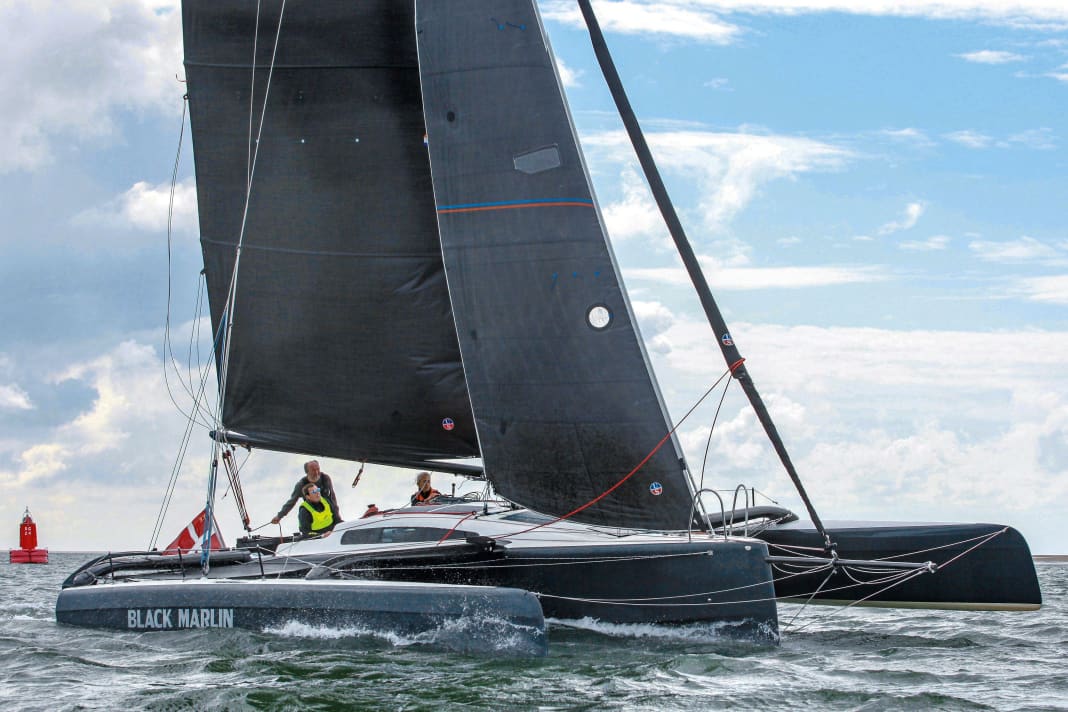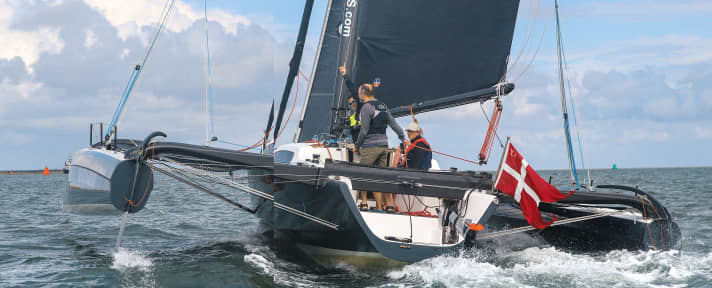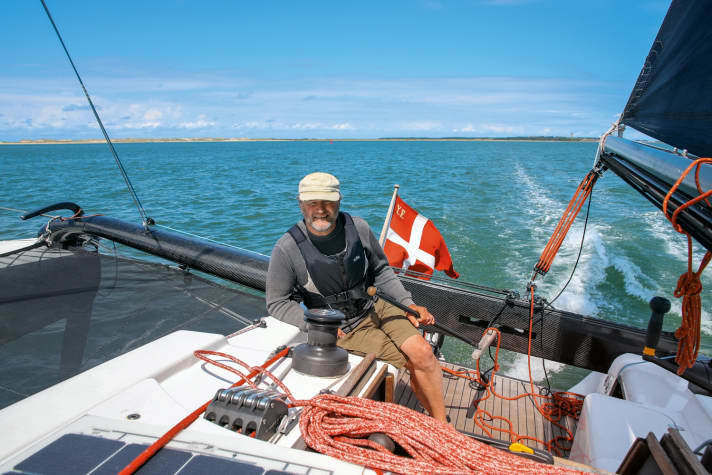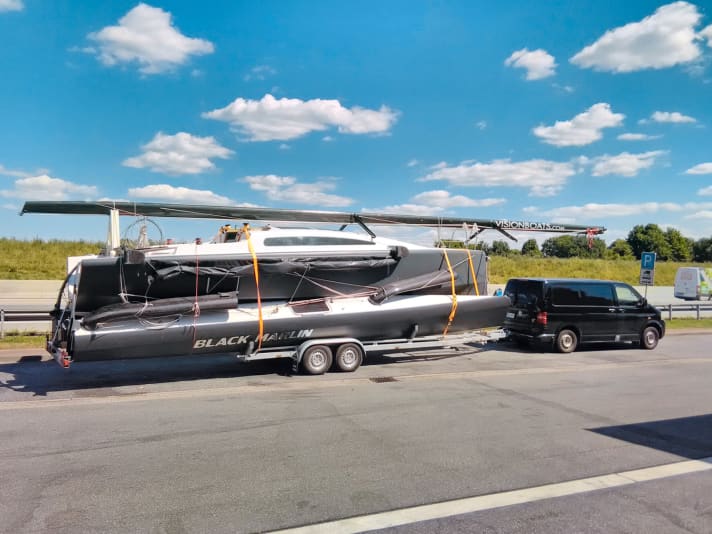





Jan Andersen didn't want to do without a teak deck after all. A thin layer, at least, in the cockpit: there had to be that much reference to a classic cruising boat. Underneath, however, there is carbon fibre again, of course. Just like everywhere else on the "Black Marlin". After all, this is probably the lightest and fastest multihull yacht that can still be trailered and is fully suitable for cruising. Despite all the weight savings, Jan Andersen reports that he can take his wife and children on a trip to England, Norway or Croatia in the summer. "I simply built the sailing boat that I wanted myself," says the "Marlin" maker. Well, that's what other boat builders say too, whose shipyard is not much more than a heated tent illuminated by neon lights standing somewhere on a green field.
However, under these conditions at home on Funen, the modest Dane has become a Silverrudder series winner in just one and a half years. In 2021, he beat his own speed record at the regatta and completed the 134 nautical mile route around his own island in less than 15 hours. In 2022, he came second after a thrilling duel in storms, currents and calm.

No dark carbon cave
We met Jan Andersen in 2022, when he and his family were staying on Terschelling, for this report. They are on their way to Scotland. It will take them no more than two days and eleven hours to cover the 433 nautical miles to get there, giving them an average speed of over seven knots, with a top speed of 16.4 knots. The "Black Marlin", which normally weighs less than one and a half tonnes, is now a few hundred kilos heavier than on all the regattas, as the four Andersens have everything they need for a summer cruise.
The light, white-painted saloon with its sumptuous benches around the carbon fibre table has a standing height of almost two metres. Elegant cedar wood creates an exceptionally warm, cosy atmosphere in the navigation corner as well as in the spacious kitchen. It is a far cry from the gloomy carbon cave of a high-tech racer. The only thing the Andersens have done without is a shower on board, as they are more like campers - but there would have been room for one in the 9.60 metre long main hull. The door to the usual forward berth has also been omitted; a curtain will have to suffice. Instead, there are children's rooms in the two outer hulls. According to Jan Andersen, eight of them have already sailed a long trip on this 33-foot trimaran.

From wood to carbon
It is his first boat that he has produced in carbon fibre: He has always worked with wood. The first time was at 14, when he built a pirate together with his father in 1982. He later became a boat builder like his father and learnt his trade at Ring Andersen in Svendborg, one of Denmark's oldest and best-known wooden shipyards. Today he runs his own company on Funen. It's called Visionboat, a one-man show: Jan Andersen is more of an artist than a businessman and also wants to have plenty of time to simply go sailing.
His first trimaran is the "Barracuda", built in 2004 from cedar wood, 9.20 metres long, weighing 1,380 kilograms, with a mainsail area of 41 square metres. And it too was already trailerable. When the first Silverrudder took place in 2012, Andersen quickly decided to take part two days before the start. He lives on Funen, so why not, he thought. And he wins the race, which at the time still bears the subtitle "Iron Men of the Sea" and is far from being a cult regatta with several hundred participants, where even 450 starting places are sold out in two hours. In 2012, just 15 boats entered. Three years later, he took part in the single-handed race for the first time on the "Black Marlin", although the boat was not even really finished at the time. But it is already sailable, and it will be first ship home.
I simply built the sailing ship that I wanted to have myself
Andersen worked on the "Black Marlin" for 18 months in 2014/15, a full-time job. He had previously sold his "Barracuda" - he wanted something bigger, for longer distances, with more space underneath, and it also had to be seaworthy. He also manufactures the carbon fibre rotating wing mast himself; it is designed so that the entire boat can be shipped all over the world in a 40-foot container. He then built the boat again, at the request of a Swede, but in a scaled-down version with a smaller rig.
"Black Marlin" is a commodity, not an exhibit
For Jan Andersen, the "Black Marlin" is his "final" boat. "So far," says his wife Annette Bartels Andersen. The two have been together for over 30 years and have already sailed from New Zealand to the Mediterranean in a 28-foot long keeler. She is not so sure that he will not design and build a new trimaran in his small shipyard. "I'm very happy with this boat," he says, and that he never dreams of a bigger one.
However, the years of use on cruises and regattas can now be seen a little on "Black Marlin", the carbon has a few scratches here and there, and the surfaces on deck are no longer quite as sleek as they once were - a commodity, not an exhibit.
In the harbour exit of Terschelling, the almost eight-metre-wide platform is mighty expansive. On the ships that pass us, smartphones are always being pulled out, while an attached electric motorboat quietly whirs us out of the harbour. Once the new black sails are set, the trimaran quickly develops into a light-footed racing machine. You soon feel closer to flying than sailing, everything on board moves in a completely different dimension to the boats around you. The "Black Marlin" can't possibly rock along slowly, even with seven people on board and all the luggage. Yet the speed here never feels dangerous. Sailing fast is not a struggle or even stressful. The trimaran is free of nervousness, gusts can be managed in a relaxed manner via the traveller; it is both accelerator and brake at the same time. And even if the wind is only blowing at four knots, the boat can make six or seven knots through the water. "If the wind increases from eight to knots, the boat's speed increases from nine to eleven knots," says Jan Andersen

Sailing on the "Black Marlin" is simply fun
On this day, we are always travelling at eight to ten knots, even in four Beaufort winds. We cross four nautical miles in the super-narrow fairway off Terschelling in half an hour, and that includes every one of the 20 tacks. The "Black Marlin" is as agile as a dinghy and steers like one, while all the monohulls we encounter have their engines running. Basically, you don't want to have to cross alongside here, but on this trimaran it's simply fun; and happy.
This is also due to the fact that you don't have to laboriously crank up the jib again after every tack - the "Black Marlin" sails with a practical self-tacking jib. It is designed as a single-handed boat. This means that the headsail, traveller and boom can be easily moved from port to starboard and back again, and nobody needs to duck under the mainsail. Jan Andersen simply makes one racing tack after the other until it finally forms an ideal cross, without the need for any commands on board. He is a trained single-handed sailor, and a very good one at that.
A test run of one and three-quarter hours easily takes us 13 nautical miles, and completely relaxed. The only thing you don't really want to do as the helmsman of the "Black Marlin" is sit on the two outer hulls, even though the trimaran has its rudder blades there - it's neither really comfortable to sit there nor is it possible to find real support on the otherwise pleasant trampoline. But if you are travelling alone, you have to stay amidships anyway, on the 2.54-metre-wide main hull, which offers space for four adults. And that's where the boat sits well on its oars.

The tablet is used to navigate, there are no electrical aids in the cockpit and nothing more than a compass is needed here: "Keep it simple" is Jan Andersen's philosophy, which in the end usually means that a boat remains light. At the same time, it is completely energy self-sufficient thanks to its solar cells.
Also because savings were made on energy consumers. There is not even a bow thruster to be thought of, nor is there an echo sounder, but why should there be: the boat has a draught of only 40 centimetres with the centreboard raised, and its downhaul, like that of the rudder blades, is equipped with safety clamps that release the line as soon as the boat touches the ground. And thanks to a Kevlar-reinforced floor, the trimaran can simply fall dry.
In 2021, Tornado Olympic sailor Roland Gäbler (bronze medallist in Sydney in 2000) won the 158-nautical-mile Vegvisir Race together with Jan Andersen. "The conditions were challenging with winds of up to 30 knots from the west," he recalls. "Our top speed was 25 knots!" The two did not reef.
Technical data "Black Marlin"
- Total length: 10,0 m
- Length, folded: 11,50 m
- Width folded: 7,80 m/3,55 m
- Wide main hull: 2,54 m
- Depth:0,40-2,10 m
- Mast height above waterline:16,50 m
- Weight ready to sail:1,460 kg
- Mainsail:46 m²
- Fock: 20 m²
- Gennaker: 85 m²
More information about the Jan Andersen shipyard and visionboats.com
This article first appeared in YACHT 19/2022 and was revised in August 2023.

